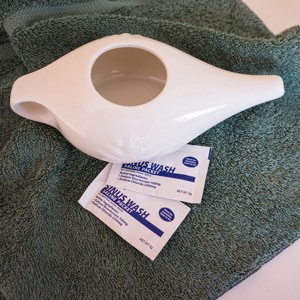
Some people, like our reader below, have adopted saline irrigation to ease sinus congestion. This condition could interfere with breathing or result in chronic headaches. Since medications don’t always help much, sufferers welcome an effective non-drug option. A new study shows that saline irrigation might also play an important role in recovery from COVID-19.
Saline Irrigation for COVID-19:
Saline nasal irrigation starting immediately after a COVID-19 diagnosis can help ease symptoms and protect people from hospitalization (Ear, Nose & Throat Journal, online Aug. 25 2022). Saline irrigation is a tradition that goes back centuries in Southeast Asia, where people regularly use neti pots. However, few Americans are familiar with this practice.
The study was conducted in Augusta, Georgia, in 2020 before vaccines for COVID-19 were available. Scientists recruited 79 overweight older adults to flush their sinuses with saline twice a day. They began within 24 hours of testing positive on a PCR COVID-19 test.
The investigators contacted the volunteers every few days to collect data on their symptoms for a month after diagnosis. One participant made a COVID-related visit to the emergency department, and another was hospitalized. None died. That comes to just over 1.2% hospitalized.
In comparison, the CDC reported that 9.5% of COVID-positive patients in the general population were hospitalized during that time frame. Sadly, 1.5% died. The researchers point out that sinus rinse bottles for saline nasal irrigation are inexpensive and easy to use. Widespread use could save lives.
You don’t have to suffer from COVID-19 to benefit from saline irrigation. One reader found this a simple way to ease sinus congestion.
Ease Sinus Congestion with Saline Spray:
Q. I have had sinus congestion problems since serving in Saudi Arabia back in 1969. My brother told me about a nasal rinse called NeilMed, but it took me a long time to try it. Now I use it morning and night. It really does work.
This part of the body is a filter, and it needs to be washed out. Is it messy? Yes. Do you need to keep the spray bottle clean? Yes. Do you need to use clean water? Yes.
Try it in privacy of your bathroom. You will be surprised at the results, that is if you actually sniffle the fluids up and down to wash the nasal spaces. Wait a while for the mucus to loosen up. Then wash and rinse again. Blow out the baddies and enjoy life.
My annual health problems associated with pollens and other junk in the air have disappeared since I started this daily regimen.
Saline Rinsing for Allergy Symptoms:
A. Saline nasal rinsing is an effective, inexpensive way to reduce allergy symptoms (Head et al, Cochrane Database of Systematic Reviews, June 22, 2018). NeilMed supplies a variety of nasal irrigation products including rinses that are premixed so you don’t have to locate purified water. An analysis of clinical trials found that irrigating with saline solution could ease sinus congestion in children with allergies (Li et al, Journal of Clinical Medicine, Jan. 9, 2019).
Using Saline to Ease Sinus Congestion from Allergies:
Q. Almost three years ago, I was bothered with allergies and took allergy medicines every day. Then I started using a neti pot with a saline solution for the entire allergy season.
Now I do not take any allergy medicines. I only have to use the neti pot when I get congested. I am SO glad to cut my ties to allergy medicines.
I’ve thought: why WOULD there be any studies to combat allergies using saline irrigation when drug companies make bank on sales of the medicines?
Research on Saline Irrigation:
A. You are right that few drug companies would underwrite research on saline solution. There have been a few studies on saline irrigation for allergies, though.
In one pilot study, 25 youngsters with runny nose year round (perennial allergic rhinitis) had fewer symptoms after using saline nasal spray for three weeks (Journal of Biological Regulators and Homeostatic Agents, Jan-Mar., 2016). A review of several earlier studies notes that nasal irrigation with saline can be helpful in cases of chronic sinus irritation (Current Allergy and Asthma Reports, Apr., 2013).
Neti Pot or Saline Spray?
As the studies suggest, you don’t have to use a neti pot to ease sinus congestion. But if you are curious about how to use this Aladdin’s-lamp-shaped implement, you can read more about it here. This ancient Ayurvedic practice appeals to many people and is not difficult to master.
Some folks prefer a more modern system of nasal irrigation, such as one made by NeilMed. Another reader found that using plain saline nasal spray twice a day was helpful in preventing sinus problems.
Bonnie compared using a neti pot and sinus irrigator:
“I have used both. Both offer great relief from the congestion and runny nose of allergies and colds. The preservative-free nasal sprays such as Simply Saline are convenient and a lot less messy than the neti pot. I stress ‘preservative-free’. It’s also buffered and makes it comfortable as well as effective. If you’re using a netti pot, make sure you use sea salt, kosher salt or pickling salt. They have no preservatives or iodine. And use a pinch of baking soda to buffer your solution.”
Lucy found she had a chronic sinus infection:
“I had chronic nasal congestion (and used saline once a day) and discovered a long-term sinus infection, thanks to a CT scan at the time of a TIA. After the antibiotic treatment my EMT MD told me to use a full bottle (about an ounce) of saline every am and again in the pm. I mix up my own and just use tap water because the risk of parasitic infection is minimal in city water. That clears out the congestion nicely and I almost never need a chemical decongestant.”
Molly added:
“I’ve had post nasal drip 24/7 for several years. A variety of possible causes have been ruled out in doctor visits, tests, and diet changes. I’m 67 and I believe it’s caused by dried out sinus mucus membranes, a matter of aging. What works best is to drink a lot of water, use the NeilMed sinus rinse twice daily along with saline nasal spray. I make my own saline solution for the rinse using 1 part soda to 3 parts pickling salt. I use the commercial spray which is convenient and inexpensive.”
Citations
- Baxter AL et al, "Rapid initiation of nasal saline irrigation to reduce severity in high-risk COVID+ outpatients." Ear, Nose & Throat Journal, online Aug. 25 2022. DOI: 10.1177/01455613221123737
- Head K et al, " Saline irrigation for allergic rhinitis." Cochrane Database of Systematic Reviews, June 22, 2018. DOI: 10.1002/14651858.CD012597.pub2
- Li CL et al, "Effectiveness of hypertonic saline nasal irrigation for alleviating allergic rhinitis in children: A systematic review and meta-analysis." Journal of Clinical Medicine, Jan. 9, 2019. DOI: 10.3390/jcm8010064
- Barberi S et al, "Hypertonic saline monotherapy in children with perennial allergic rhinitis: a pilot study." Journal of Biological Regulators and Homeostatic Agents, Jan-Mar. 2016.
- Achilles N & Mosges R, "Nasal saline irrigations for the symptoms of acute and chronic rhinosinusitis." Current Allergy and Asthma Reports, April 2013. DOI: 10.1007/s11882-013-0339-y



